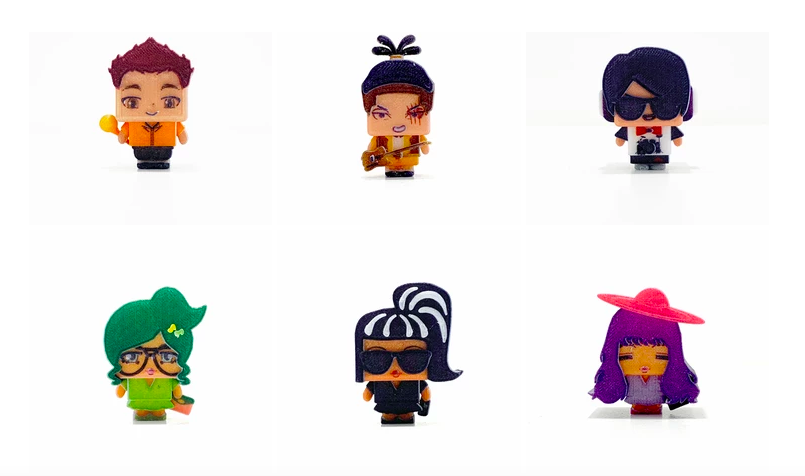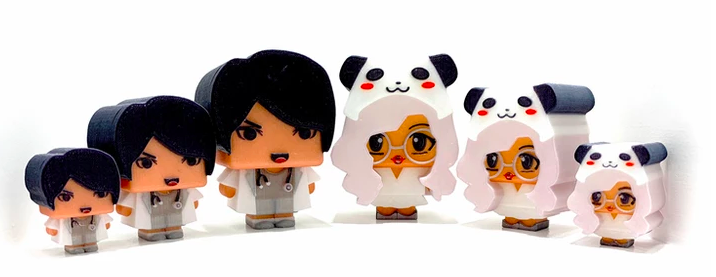Canada’s Little You has developed an interesting approach to 3D printing for consumers, with an online platform to design and 3D print custom figurines. Previously, these toys were made from gypsum, a fragile material used with the company’s Zcorp binder jetting machine. Now, through a partnership with RIZE, Inc., customers can create the same colorful Little Yous made with RIZE’s full-color RIZIUM composites, much more durable for improved hands-on play.
Little You is a pretty straightforward concept: customers can hop onto the Little You site and begin designing cute, anime-style figures. They select hairstyles, clothing, accessories, facial features and more, choosing whatever color they prefer for each item. Once complete, they can save and purchase their character.
With the sandstone-like material available with binder jetting, these figures can be gazed upon and gently cared for, but rough-and-tumble play is likely out of the question without some broken toys and broken hearts. Little You now allows customers to 3D print their characters in Rizium GF, a glass-fiber reinforced thermoplastic.
RIZE notes, “With RIZE’s materials, Little You-designed custom figures can move off the shelf and into the hands of the creator. Kids can carry their creations anywhere – toss them in their backpacks, carry then in their pockets, share them with friends, or dance with them in the rain. Kids can select and add different costumes to their 3D figure, and change color, size and position for different add-on accessories.”
Binder jetting requires significant post-processing: excavating the prints from the powder and depowdering them, before possible infiltration and coating. In turn, the RIZE-printed products from Little You are less expensive and can be printed at a larger scale. ZCorp-made Little You figures are priced at $25, $39, and $59 for 3, 4, and 5 cm characters, respectively. Those made with RIZE’s technology are available at 5, 8, and 10 cm in height and are priced at $29, $59 and $89 respectively. Christina Guo, founder of Little You, noted, “RIZE’s material is more playable and durable, so we market it as more suitable for making a toy for kids to play with.”
This marks a potential important shift in full-color 3D printing, a technology segment with some of the highest potential for consumer-directed applications. When consumer 3D printing was at its peak in terms of media hype, the most exciting products were those that were 3D printed with full-color binder jet. In particular, printed replicas of customers made from 3D scans drew a lot of attention as they demonstrated the possibilities of consumer-specific, full-color goods at a relatively low cost.
The biggest drawback was that the gypsum material and binder were too delicate for custom dolls. That didn’t mean that it wasn’t tried. AvaStars attempted to create 12-inch-tall action figures where the entire body was mass produced while the heads were 3D printed based on facial scans obtained at retail locations. Other concepts, like Makies (acquired by Disney) and KitBash’s Quinn doll, used monochromatic technologies, like selective laser sintering and fused deposition modeling (FDM) respectively, to mass-produce single color figures. The former were customizable, but the latter was not.
Meanwhile, there were or are other full-color technologies like Mcor’s paper printing process and PolyJet from Stratasys, which is and was much too expensive for mass production of consumer goods. Neither are or were capable of making items that could handle much hands-on use, either.
Here, RIZE’s augmented polymer deposition (ADP)—which sees an inkjet printhead used to deposit CMYK colors onto thermoplastic during an FDM-style 3D printing process—could change things. FDM is traditionally known for providing the most durable parts possible with 3D printing. Adding full color to the mix could make it quite unstoppable, if the color quality is on par with or better than binder jetting and if it can be scaled up.
RIZE does not have specific figures with which to compare its ADP with Zcorp binder jetting; however, RIZE founder and chief technology officer Eugene Giller, who was formerly a materials scientist at ZCorp, told us:
“RIZE’s technology and full-color capabilities were developed by the same team who worked at ZCorp years back. The team made numerous improvements in the color algorithm, so RIZE’s colors are brighter and very consistent. ZCorp colors really depend on the post-processing and strongly depend on the infiltration and waxing process. In addition, RIZE colors do not fade like those of ZCorp.”
RIZE is also GREENGUARD-certified, meaning that it may be inherently more consumer friendly as a technology. They also claim that RIZIUM can be recycled, though I am unsure how recyclable fiber glass-reinforced plastic is by traditional methods.
It’s also interesting to see RIZE push its technology into the consumer space. Though it has always used its office-friendliness to target the education market, prior applications for its full-color technology have included marking parts for manufacturing and traceability reasons. The RIZE press release notes, “The agreement also allows Little You to more efficiently scale its operations backed by RIZE’s growing ecosystem.” Perhaps the firm will scale up its printing process?
The biggest competition for RIZE in terms of tackling full-color figurines and the like will be from HP, whose Multi Jet Fusion (MJF) is also capable of 3D printing full-color, durable parts. So far, their technology hasn’t been targeted toward this sort of consumer application, however. Maybe there’s something I’m missing about MJF. Perhaps it’s that the consumer space previously wasn’t ready for 3D printing and HP hasn’t approached it yet. Or maybe there’s something happening behind the scenes and we’ll be taken by surprise soon enough.
Subscribe to Our Email Newsletter
Stay up-to-date on all the latest news from the 3D printing industry and receive information and offers from third party vendors.
You May Also Like
3D Printing News Unpeeled: A $3000 SLS System, Construction Subsidies and Parameters
The Housing Affordability Crisis is one of Canadian President Trudeau’s biggest issues. Now the government has made subsidies available, including scaling new technologies, 3D printed housing and libraries of reapproved...
“Bundled Light” Enables High Quality Plastic 3D Printing from LEAM
Naturally, we expect current 3D printing methods to continuously improve, but it continues to do so in the most surprising ways. The latest development comes from LEAM, a startup spun...
Each to Their Own: Exploring Creality’s Latest Ender Trio as the Company Strengthens Its Commitment to 3D Printing Advocacy
Creality has reaffirmed its commitment to promoting 3D printing. The launch of the Ender-3 V3 SE, Ender-3 V3 KE, and Ender-3 V3 showcases the company’s dedication to catering to diverse...
3D Printing News Briefs, March 23, 2024: AM in the US Coast Guard, Navy, & More
In today’s 3D Printing News Briefs, we’re discussing the use of 3D printing in various branches of the military, including the U.S. Coast Guard, the U.S. Navy, and the German...

































